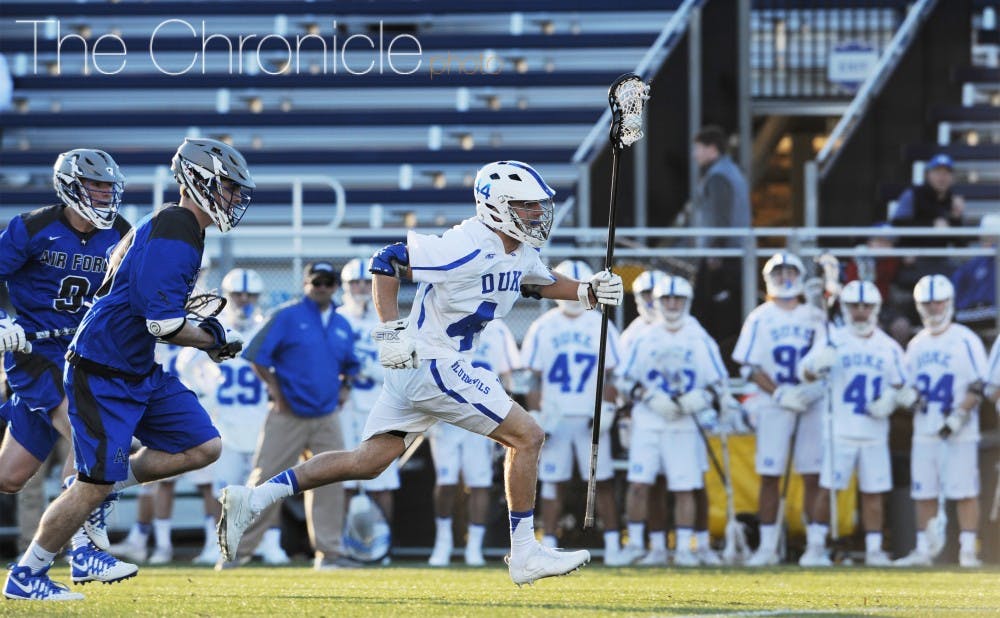People like to say that lacrosse is the fastest game played on two feet.
As far as Duke senior Ethan Powley is concerned, that is perfectly fine. The Wake Forest, N.C., native has spent the majority of his career learning from one of the sport’s most decorated teachers, and after overseeing Powley’s offseason position change from defense to long-stick midfielder, Duke head coach John Danowski is ready to turn his newly-minted agent of chaos loose on the rest of the ACC.
Before making the switch to long-stick midfielder, Powley started the majority of the past two seasons at close defense, living in the face of opposing attackmen and making every offensive possession as unpleasant as possible. In 19 games last season, Powley caused 21 turnovers, the most on the team, and picked up 36 ground balls.
With the graduation of long-time team leaders Deemer Class and Myles Jones, the Blue Devils are turning to Powley and fellow seniors Jack Bruckner, Danny Fowler and Kyle Rowe to set the tone for the rest of the squad.
“When you are a senior, now for the first time you look around and say, ‘Where is Myles or Deemer?’” Danowski said. “All the seniors are transitioning to that experience. And for a guy like Ethan, not only is he trying to play a new position, but he is also realizing, ‘Wow, there is nobody else that I defer to.’ Everyone is looking at [Ethan] and it is hard. That is not an easy thing, and guys play their way into that.”
Powley and goalkeeper Fowler are responsible for communicating and organizing the rest of the defense as possessions materialize on the other side of the field.
Possession during a lacrosse game can change instantly. The top-down view of the opposing offense that Powley often has when trailing the fast break is invaluable for Fowler and the back line of the defense. Fowler is often screened to the offensive player’s true intentions by his teammates and the crowds around the crease.
“It is just a different spot on the the field,” Powley said of his position switch. “I am up top now so I’m kind of looking down on the defense. It is more of a communicative role where I’m trying to instruct the recoveries, whereas down low I was defending the dodge from behind the cage.”
Powley’s new position has become increasingly important in today’s lacrosse climate. As incoming recruits come into college more athletic and prepared than ever before, coaches must mold their game plans around containing offensive midfielders that have the ability to score on the run in transition and attack from behind the goal in inverted sets.
The ability for a long-pole to both blanket a midfielder and attack the goal in transition can add a new wrinkle to a game that coaches struggle to plan for.
Some of the most successful teams in recent memory illustrate this matchup problem when a long-pole can stretch the defense in unsettled situations, as Brown senior long-stick midfielder Larken Kemp earned All-American honors after keying the team’s Final Four run last year with six goals and 12 assists in the transition game.
Even at Duke, the position has been critical. When Powley was a freshman, he learned under the tutelage of Luke Duprey, who earned third-team All-American accolades after sparking Duke’s run to the Final Four with 22 caused turnovers, including three in a crucial overtime victory against ACC rival North Carolina.
A few years earlier, CJ Costabile, a former Tewaaraton Award finalist, scored the game-winning goal in overtime to beat Notre Dame in the 2010 national championship game. The image of Costabile streaking down the middle of the field gearing up to shoot overhand with his long-pole is seared into Duke sports lore forever—it clinched the Blue Devils’ first national title in men’s lacrosse.
It is no surprise that Powley looks poised to add his name to that list this year—Danowski has always stressed the importance of capitalizing on unsettled situations to gain the advantage, with long-stick midfielders playing an integral role.
“They are the guys that can create some havoc, you know who can make a mistake but yet make up for it because they have a six-foot pole.” Danowski said. “They play such an important role, communicating in the box, being a pest between the lines and creating transition offense. Hopefully, the great ones can do all three.”
Powley and junior Peter Welch have already played a major role in the Blue Devil game plan this season. Powley, the defensive-minded veteran, and Welch, a nimble creator with the stick in his hand, combine to give Danowski worthy leaders on the wing and in transition.
Welch, a Bernardsville, N.J., native, has an assist and nine ground balls in five games, and like Powley he will look to guide the duo’s younger teammates with the challenge of ACC play on the horizon for an inexperienced team that has already taken two losses on the chin.
“Every week is a different challenge; each team runs a different offense.” Powley said. “We just try to focus on film and try to learn the different styles or whether a team is running a different set or recovery. It is all about helping some of the younger players understand the faster pace of the game.”
Ben Leonard contributed reporting.
Get The Chronicle straight to your inbox
Signup for our weekly newsletter. Cancel at any time.

